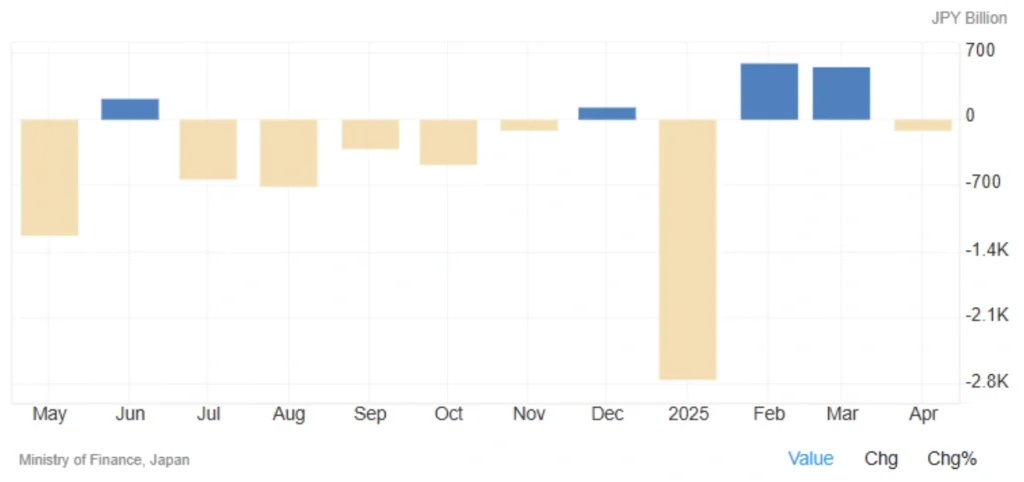
Significant Decline in Japan’s Trade Deficit in April
Japan’s trade deficit in April 2025 dropped to ¥115.85 billion, compared to ¥504.69 billion in the same month last year. However, the result fell short of market expectations for a ¥227.1 billion surplus. The improvement in the deficit was primarily due to a decline in imports and growth in exports, although the pace of export growth slowed due to U.S. tariffs.
Japan’s Trade Balance – April 2025: Key Figures
| Indicator | Value | YoY Change |
|---|---|---|
| Exports | ¥9,157.16 billion | ▲ 2% (seventh consecutive rise) |
| Imports | ¥9,273.00 billion | ▼ 2% (second annual decline this year) |
| Trade Balance | ¥-115.85 billion | Improved from ¥-504.69 billion |
| Market Forecast | ¥+227.1 billion | Not met |
Educational Note: What Is the Trade Balance and Why Does It Matter?
The trade balance is the difference between a country’s exports and imports over a given period.
- A trade surplus (exports > imports) indicates strong foreign demand and supports economic growth.
- A trade deficit (imports > exports) may point to weak exports or import dependence.
🔍 For Japan, as an export-driven economy, the trade balance plays a crucial role in GDP growth, currency valuation, and monetary policy decisions.
Economic Impact Analysis: Trade Data, Policy Support, and Currency Markets

The narrowing of the trade deficit to around ¥116 billion marks a positive shift from last year. However, the failure to achieve the expected surplus raises concerns over the impact of U.S. tariffs.
Exports grew for the seventh consecutive month (2%), though at the slowest pace in this streak, mainly due to the U.S. imposing higher import tariffs on Japanese goods.
Imports declined by 2% in April (following a 1.8% increase in March). This decline was less severe than the 4.5% forecast, reflecting the impact of domestic government support measures, including:
- Fuel subsidies
- Partial coverage of household electricity bills
These measures helped sustain a portion of domestic import demand.
📌 Given the weak external demand and pressure on exports, the Bank of Japan (BoJ) is likely to maintain its supportive policies in the coming months.
Read More: Japan’s Economy Contracts in Q1 2025
Final Summary: Opportunities and Risks
🔹 Opportunities:
- Year-over-year improvement in trade balance signals positive trends for the yen and current account
- Government support policies have partially cushioned import declines
- Export stability despite tough trade conditions is encouraging
🔸 Risks:
- Ongoing U.S. tariff pressure could continue to hamper export growth
- Potential drop in foreign demand from key partners (China, EU)
- Prolonged weak import figures may indicate sluggish domestic consumption
Overall, the April data show Japan’s economy is still striving to maintain trade balance amid geopolitical and tariff-related challenges, increasingly relying on domestic support to stabilize imports.
Share
Hot topics

Will 2026 Be a Turning Point for Crypto Regulation in the U.S.?
The cryptocurrency world is gearing up for a transformative year as a pro-crypto administration, led by Donald Trump, prepares to take charge in the United States. With a Congress expected...
Read more




Submit comment
Your email address will not be published. Required fields are marked *